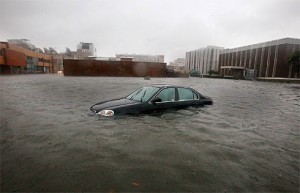When Global Warming Hits Home (Literally)
 In a recent PBS documentary, the mayor of Norfolk, Virginia, Paul Fraim, talks about how flooding has become a monthly occurrence in his town, and how global warming and sea level rise are as much a daily issue for him as education and fighting crime. In some parts of Norfolk, streets turn into rivers at high tide. Homes are flooded five out of six years. People lose their carpets, their appliances, their savings. And they can’t afford to move elsewhere.
In a recent PBS documentary, the mayor of Norfolk, Virginia, Paul Fraim, talks about how flooding has become a monthly occurrence in his town, and how global warming and sea level rise are as much a daily issue for him as education and fighting crime. In some parts of Norfolk, streets turn into rivers at high tide. Homes are flooded five out of six years. People lose their carpets, their appliances, their savings. And they can’t afford to move elsewhere.Sea levels have risen 14 inches in Norfolk since 1930–almost double the global rate. Part of this alarming change is due to the natural sinking of the area’s soggy tidal lands, but part of it is due to the rising sea levels brought about by global warming. Like stranded polar bears in the North Pole, like disappearing island nations in the Pacific, waterlogged Norfolk is yet another symbol of global warming at work. And even though Norfolk is within spitting distance of our nation’s capital, Congress still hasn’t seemed to grasp the seriousness of the situation.
Turning a blind eye to the realities of global warming is a dangerous game. Scientists predict that sea levels will rise anywhere from 7 inches to 78 inches in the next 100 years (depending, in part, on how much we do to curb global warming pollution), which means that in a few generations, nearly five million people who currently live within 4 feet of high tide could be in the same boat as the residents of Norfolk.
New research shows that global warming will double the chance of a hundred-year flood occurring in many locations within the next 18 years. In some areas, the chance is tripled.
Nearly half the states in the nation will be affected by rising sea levels. Despite these odds, for the most part, we are financially, structurally, and administratively unprepared to deal with the most immediate consequences of global warming.
Bailing out after a flood is a major expense not only for swamped cities, but for taxpayers all over the country. FEMA, the Federal Emergency Management Agency, spent more than $100,000 per home in Norfolk to raise residences above expected water levels. The National Flood Insurance Program (NFIP), run by FEMA, is nearly $18 billion in debt, and has had to borrow money from the Treasury to stay afloat.
You can return to the main Market News page, or press the Back button on your browser.

